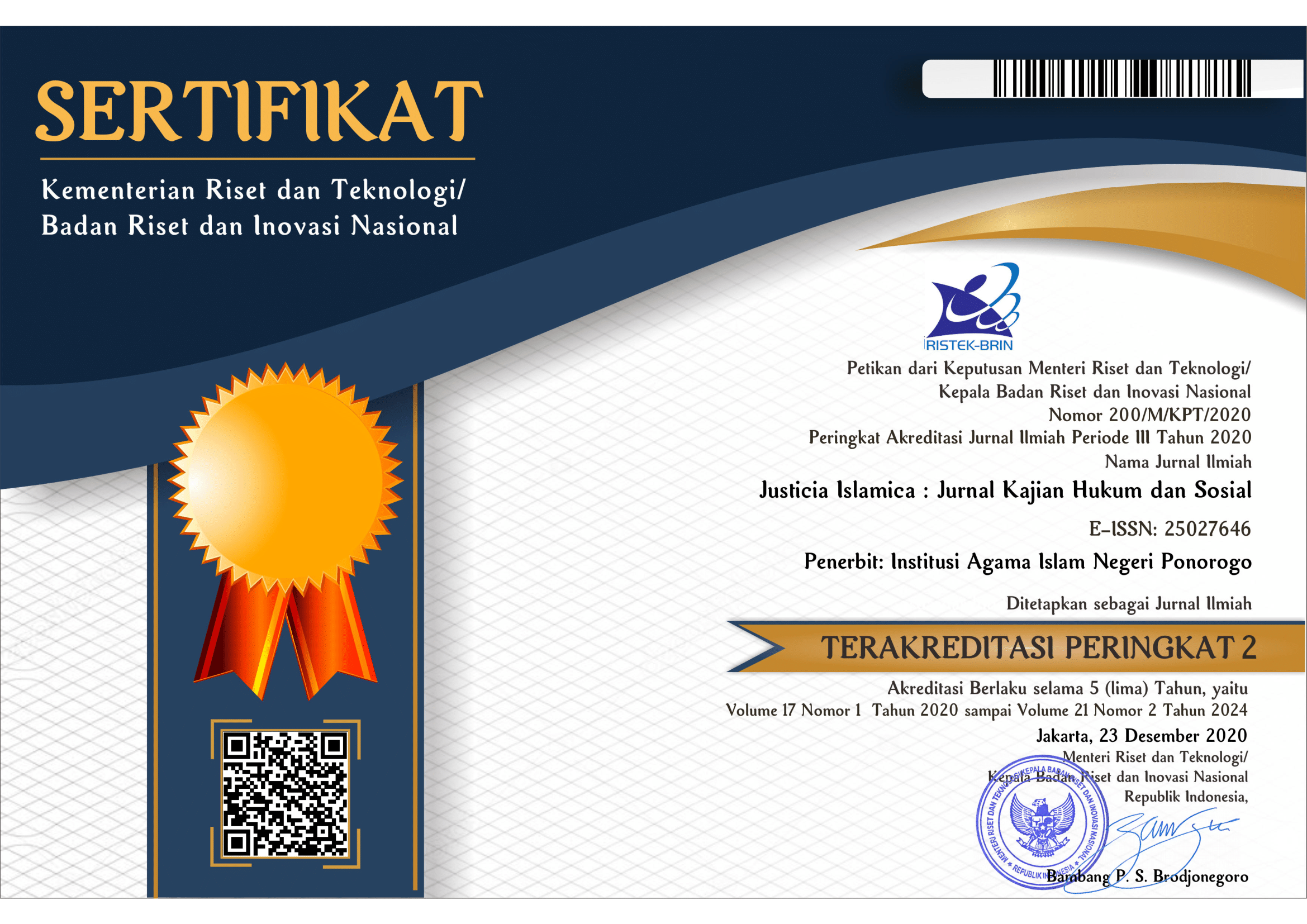The Criminal Cases of Children in Conflict With The Law: Litigation and Non-Litigation Resolutions
DOI:
https://doi.org/10.21154/justicia.v17i1.1711Keywords:
Legal protection, Litigation, Non-litigation, Children With Legal ConflictsAbstract
The increasing number of child cases in Ponorogo Regency from 2015 to 2019 requires fast, simple handling and can deter children. From this, problems can be formulated related to how the process of resolving child cases is through litigation and non-litigation at the Police, District Courts, KPPA Ponorogo, and LK3 Ponorogo. This research is a qualitative descriptive study, with a sociological juridical approach, and the data are obtained based on field research to related institutions, then analyzed by inductive analysis. The settlement of cases of children in conflict with the Law is conducted by litigation to the Police and the Ponorogo District Court by the relevant Law. Meanwhile, non-litigation, namely diversion, has not been effective because it was found that there was a repetition of crimes, such as theft, raiding, which were carried out by several children, indicating that the non-litigation approach had not provided a deterrent effect on children. Meanwhile, in non-litigation terms, the roles of institutions in Ponorogo Regency, such as the KPPA, LK3 are still lacking even though their handling is by the Child Protection Law and the Child Justice System Law. To see and understand the handling of children dealing with the Law directly, it is also known that law enforcement officers in Ponorogo choose to prioritize human values with non-litigation even though there are not by the Law; this is what contributes to this research.
Meningkatnya kasus anak yang terjadi di Kabupaten Ponorogo dari Tahun 2015 sampai dengan Tahun 2019 membutuhkan penanganan yang cepat, sederhana dan dapat memberikan efek jera terhadap anak. Dari hal tersebut, dapat dirumuskan permasalahan terkait bagaimana proses penyelesaian perkara anak secara litigasi dan non litigasi di lembaga Kepolisian, Pengadilan Negeri, KPPA Ponorogo, serta LK3 Ponorogo. Penelitian ini merupakan penelitian diskriptif kualitatif, dengan pendekatan yuridis sosiologis, dan data diperoleh berdasarkan penelitian lapangan ke lembaga-lembaga terkait, kemudian dianalisis dengan analisis induktif. Penyelesaian kasus anak yang berkonflik dengan hukum secara litigasi ke lembaga Kepolisian dan Pengadilan Negeri Ponorogo sesuai dengan Undang-Undang terkait. Sedangkan secara non litigasi yaitu dengan diversi belum efektif, karena ditemukan adanya pengulangan pidana yang dilakukan oleh beberapa anak menunjukkan bahwa pendekatan non-litigasi belum memberikan efek jera terhadap anak. Sedangkan secara non litigasi, peran lembaga-lembaga yang ada di Kabupaten Ponorogo, seperti KPPA, LK3 masih sangat kurang walau penanganannya sudah sesuai dengan Undang-Undang Perlindungan Anak dan Undang-Undang Sistem Peradilan Anak. Jadi selain melihat dan memahami penanganan anak berhadapan dengan hukum secara langsung, juga diketahui bahwa aparat penegak hukum di Ponorogo memilih mengedepankan nilai-nilai kemanusian dengan non-litigasi walaupun ada hal yang kurang sesuai dengan undang-undang, hal inilah yang menjadi kontribusi dalam penelitian ini.
References
Journal
Alputila, M. J., M. A. Tajuddin, and Kahar. “Diversion Approach As An Alternative Case Resolution Son Of The Conflict With The Law On Child Criminal Justice System (Case Study Of Merauke).” IOP Conference Series: Earth and Environmental Science 343 (November 2019): 1”“7. https://doi.org/10.1088/1755-1315/343/1/012249.
Amdani, Yusi. “Konsep Restorative Justice Dalam Penyelesaian Perkara Tindak Pidana Pencurian Oleh Anak Berbasis Hukum Islam Dan Adat Aceh.” Al-´Adalah 13, no. 1 (2016): 76”“81. https://doi.org/10.24042/adalah.v13i1.1130.
””””””. “Proses Pelaksanaan Penyelesaian Perselisihan Di Lembaga Peradilan Adat Aceh Tingkat Gampong (Desa).” Asy-Syir’ah: Jurnal Ilmu Syari’ah dan Hukum 48, no. 1 (January 1, 2014): 231”“60. https://doi.org/10.14421/asy-syir'ah.2014.%x.
Analiyansyah, and Syarifah Rahmatillah. “Perlindungan Terhadap Anak Yang Berhadapan Dengan Hukum (Studi Terhadap Undang-Undang Peradilan Anak Indonesia dan Peradilan Adat Aceh).” Gender Equality: International Journal of Child and Gender Studies 1, no. 1 (March 1, 2015): 51”“68. http://dx.doi.org/10.22373/equality.v1i1.779.
Ernis, Yul. “Diversi dan Keadilan Restoratif Dalam Penyelesaian Perkara Tindak Pidana Anak di Indonesia (Diversion And Restorative Justice In Case Settlement Of Juvenile Justice System In Indonesia).” Jurnal Ilmiah Kebijakan Hukum 10, no. 2 (February 13, 2017): 163”“74. https://doi.org/10.30641/kebijakan.2016.V10.163-174.
Fajar Ari, Sadewo, Abdurrahman Hamidah, and Aryani Fajar Dian. “The Application Of Restorative Justice System Through The Diversion Of Children In Conflict With Laws In Central Java Polda (Regional Police Of The Republic Of Indonesia).” International Journal of Psychosocial Rehabilitation 24, no. 2 (February 1, 2020): 3802”“10. https://doi.org/10.37200/IJPR/V24I2/PR200701.
Fitriani, Ifa Latifa. “Islam dan Keadilan Restroratif Pada Anak Yang Berhadapan Dengan Hukum.” IN RIGHT: Jurnal Agama dan Hak Azazi Manusia 2, no. 1 (March 24, 2017). http://202.0.92.5/syariah/inright/article/view/1239.
Hirdayadi, Israr, and Hera Susanti. “Diversi Dalam Sistem Peradilan Pidana Anak Di Indonesia dan Tinjauannya Menurut Hukum Islam.” Legitimasi: Jurnal Hukum Pidana dan Politik Hukum 6, no. 2 (December 4, 2018). https://doi.org/10.22373/legitimasi.v6i2.3954.
Hutahaean, Bilher. “Penerapan Sanksi Pidana Bagi Pelaku Tindak Pidana Anak.” Jurnal Yudisial 6, no. 1 (March 11, 2013): 64”“79. https://doi.org/10.29123/jy.v6i1.119.
Mubarok, Zakki, and Achmad Sulchan. “The Roles Of Investigator In Implementing Diversion On Children Criminal Action.” International Journal of Law Reconstruction 2, no. 1 (March 1, 2018): 41. https://doi.org/10.26532/ijlr.v2i1.2992.
Nuqul, Fathul Lubabin, and Ardana Reswari Miranda Ningrum. “Considering the Potential of Pesantren’s Constribution in Diversion Programs for Juvenile Offenders.” Proceeding of International Conference on Engineering, Technology, and Social Sciences (ICONETOS) 1, no. 1 (February 8, 2020): 25”“28.
Qomaruddin, Muchammad Qomaruddin, Gunarto Gunarto, and Aryani Witasari. “Legal Flexibility in Children Diversion Which Conflict With the Law (ABH) Case Study At Ex Residency of Cirebon Jurisdiction.” Jurnal Daulat Hukum 3, no. 1 (April 12, 2020): 55”“62. https://doi.org/10.30659/jdh.v3i1.8456.
Rharve, S Kalo, Ediwarman, and A Syahrin. “Implementation of Diversion in General Prosecutor Levels on Children as Criminal Offenders According to Law No. 11 of 2012 on Juvenile Justice System.” In Proceedings of the International Conference on Law, Governance and Islamic Society (ICOLGIS 2019). Banda Aceh, Indonesia: Atlantis Press, 2020. https://doi.org/10.2991/assehr.k.200306.202.
Sani, Adam, Rusjdi Ali Muhammad, and Mohd Din. “Pemidanaan Anak Menurut Konsepsi Hukum Islam Dan Hukum Pidana Indonesia.” Jurnal Ilmu Hukum 3, no. 3 (July 18, 2015). http://www.jurnal.unsyiah.ac.id/MIH/article/view/4776.
Saputra, Andre Dwijaya, Elwi Danilm, and Yoserwan Yoserwan. “The Role of Investigator in Applying Diversion to Children in Conflict with the Law in the Jurisdiction of Padang City Police.” International Journal of Multicultural and Multireligious Understanding 6, no. 5 (October 24, 2019): 455”“70. https://doi.org/10.18415/ijmmu.v6i5.1113.
Setyowati, Dewi. “Diversion in the Child Criminal Justice System as an Effort to Implement Restorative Justice.” Unram Law Review 4, no. 1 (April 23, 2020): 64”“73. https://doi.org/10.29303/ulrev.v4i1.108.
Trimartini, Erna, Hartiwiningsih, and Widodo Tresno Novianto. “Child Diversion Application Policy That Has a Conflict with Law to Make a Restorative Justice in Indonesia.” In Proceedings of the International Conference on Law, Economics and Health (ICLEH 2020). Semarang, Indonesia: Atlantis Press, 2020. https://doi.org/10.2991/aebmr.k.200513.063.
Tuharyati, Yanny. “Penyelesaian Kasus Anak Di Kabupaten Bondowoso.” Jurnal Penelitian Ipteks 1, no. 1 (January 2016): 22. https://doi.org/10.32528/ipteks.v1i1.262.
Zulfa, Eva Achjani. “Anak Nakal: Diversi dan Dilema Penerapannya.” Jurnal Hukum & Pembangunan 39, no. 4 (December 3, 2009): 418”“36. http://dx.doi.org/10.21143/jhp.vol39.no4.290.
Book
Atmasasmita, Romli. Sistem Peradilan Pidana: Perspektif Eksistensialisme Dan Abolisionisme. Bandung: Eresco, 1996.
Bogdan, Robert, and Sari Knopp Biklen. Qualitative Research for Education: An Introduction to Theories and Methods. 5th ed. Boston, Mass: Pearson A & B, 2007.
Mardjono Reksodiputro. Sistem Peradilan Pidana Indonesia (Melihat Kepada Kejahatan Dan Penegakan Hukum Dalam Batas-Batas Toleransi). Jakarta: UI-Press, 1993.
””””””. Sistem Peradilan Pidana: “Peran Penegak Hukum Melawan KejahatanPerlindungan Hak Asasi Manusia Dalam Sistem Peradilan Pidana.” Jakarta: Pusat Pelayanan Keadilan dan Pengabdian Hukum UI, 1994.
Meleong, Lexy J. Metologi Penelitian Kualitatif. Bandung: PT Remaja Rosdakarya, 1989.
Merriam, Sharan B., and Edwin L. Simpson. A Guide to Research for Educators and Trainers of Adults. Malabar, Fla: R.E. Krieger Pub. Co, 1984.
Mansur, Dikdik M. Arief, and Elisatris Gultom. Urgensi Perlindungan Korban Kejahatan: Antara Norma Dan Realita. Jakarta: Raja Grafindo Persada, 2007.
Nasir Djamil. Perlindungan Hukum Pidana Bagi Anak Di Indonesia. Jakarta: Raja Grafindo Persada, 2011.
Website
Pramesti, Tri Jata Ayu. “Hal-Hal Penting Yang Diatur Dalam UU Sistem Peradilan Pidana Anak.” hukumonline.com/klinik. Accessed September 22, 2020. https://www.hukumonline.com/klinik/detail/ulasan/lt53f55d0f46878/hal-hal-penting-yang-diatur-dalam-uu-sistem-peradilan-pidana-anak/.
Downloads
Issue
Section
License
Requirements to be met by the author as follows:
- Author storing copyright and grant the journal right of first publication manuscripts simultaneously with licensed under the CC BY-SA allows others to share the work with a statement of the work's authorship and initial publication in this journal.
Authors can enter into the preparation of additional contractual separately for the non-exclusive distribution of a decadent version of the journal issue (e.g., post it to an institutional repository or publish it in a book), with the recognition of initial publication in this journal.
Authors are allowed and encouraged to post their work online (e.g., in institutional repositories or on their website) before and during the submission process because it can lead to productive exchanges and citations earlier and more severe than published works. (see The Effect of Open Access).
This work is licensed under CC BY-SA.


















